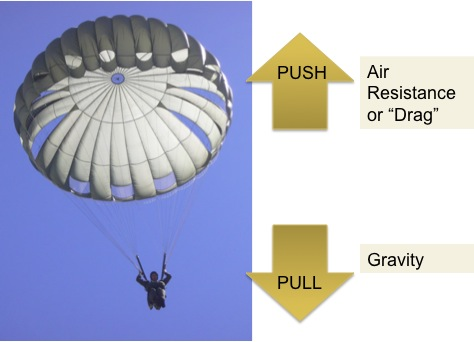The effects of air resistance on objects
The effects of air resistance on objects
By Ayad Alhazmi
According to NASA, “Drag is a mechanical force. It is generated by the interaction and contact of a solid body with a fluid (liquid or gas)”. Think about it like “air friction”, another way of saying air resistance is drag. The term drag is used commonly with aerodynamics. It is an element of a plane/jet. The four elements of a plane/ jet is lift, weight, thrust, and drag. Drag is very important when it comes to flight. If you can’t overcome drag then your plane goes backwards. The only way to overcome drag is with thrust.
As stated previously drag is a term used for planes and jets. But, air resistance is the general term. For example the wind is blowing against you as you run, so to run the same speed if the wind was not blowing as hard it would take more energy. Another example is driving a car in a rainy day. When it is raining outside, the wind blows hard, if someone was to drive the car in the opposite direction it will need more gasoline to drive the same pace as if it was a sunny day.
There is three main types of air resistance (or drag), vortices derive, Lift Induced, Parasitic, and Wave drag, and parasitic drag. Vortices derive is mixed air in a variety of pressures and that is needed to create lift. As the lift of the aircraft increases, so does the lift induced drag. The second type of air resistance is Lift Induced, Parasitic. As previously stated, as the lift from the aircraft increases, so does the lift induced drag; lift induced drag is how the object reacts to the high pressure of air resistance. Have you seen an airplane fly of? If you have you would see the airplane go to a inverted position and you think it’s not right, but that is the result of lift induced drag. The last type of air resistance is Wave drag. Wave drag is drag that is caused when an object moves through the air at such high speeds. An example of wave drag is a jet breaking the sound barrier, when a jet breaks the sound barrier the boost of a jet creates a loud boom, this is called a sonic boom.Those are the three main types of air resistance.
The next steps of this research is to see if when breaking the sound barrier, is there drag. The research will have to gather more data on wave drag. They should also make an experiment with a drone and gather data on the drag. Then after the multiple trials scientist should try to make a different design of a drone. If it succeeds through another three trials it should be a new design of a jet that can create less drag.


https://www.grc.nasa.gov/www/k-12/airplane/drag1.html
https://www.universetoday.com/73315/what-is-air-resistance/
By Ayad Alhazmi
According to NASA, “Drag is a mechanical force. It is generated by the interaction and contact of a solid body with a fluid (liquid or gas)”. Think about it like “air friction”, another way of saying air resistance is drag. The term drag is used commonly with aerodynamics. It is an element of a plane/jet. The four elements of a plane/ jet is lift, weight, thrust, and drag. Drag is very important when it comes to flight. If you can’t overcome drag then your plane goes backwards. The only way to overcome drag is with thrust.
As stated previously drag is a term used for planes and jets. But, air resistance is the general term. For example the wind is blowing against you as you run, so to run the same speed if the wind was not blowing as hard it would take more energy. Another example is driving a car in a rainy day. When it is raining outside, the wind blows hard, if someone was to drive the car in the opposite direction it will need more gasoline to drive the same pace as if it was a sunny day.
There is three main types of air resistance (or drag), vortices derive, Lift Induced, Parasitic, and Wave drag, and parasitic drag. Vortices derive is mixed air in a variety of pressures and that is needed to create lift. As the lift of the aircraft increases, so does the lift induced drag. The second type of air resistance is Lift Induced, Parasitic. As previously stated, as the lift from the aircraft increases, so does the lift induced drag; lift induced drag is how the object reacts to the high pressure of air resistance. Have you seen an airplane fly of? If you have you would see the airplane go to a inverted position and you think it’s not right, but that is the result of lift induced drag. The last type of air resistance is Wave drag. Wave drag is drag that is caused when an object moves through the air at such high speeds. An example of wave drag is a jet breaking the sound barrier, when a jet breaks the sound barrier the boost of a jet creates a loud boom, this is called a sonic boom.Those are the three main types of air resistance.
The next steps of this research is to see if when breaking the sound barrier, is there drag. The research will have to gather more data on wave drag. They should also make an experiment with a drone and gather data on the drag. Then after the multiple trials scientist should try to make a different design of a drone. If it succeeds through another three trials it should be a new design of a jet that can create less drag.
https://www.grc.nasa.gov/www/k-12/airplane/drag1.html
https://www.universetoday.com/73315/what-is-air-resistance/

Comments
Post a Comment